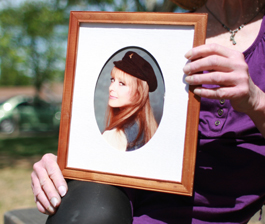home | north bay bohemian index | news | north bay | news article

Photograph by Gabe Meline
PAST LIVES: Jeri Becker, now 60, holds a portrait of herself from 1983.
On the Outside
Released after 24 years behind bars, a 'model prisoner' finds her footing in the real world
By Leilani Clark
As Jeri Becker's prison sentence stretched from two years to 24, her life constrained to a cell and a prison yard, she made a vow that when she got out, if she got out, she would live in a cabin by the water. Now, seven years after being paroled, Becker lives in a little house near the Russian River. She makes art. She writes. She talks to her best friend and ex-cellmate Vonda White on the phone everyday.
But it's not all fairy-tale ending for the "model prisoner," the one that trial judge Warren E. McGuire described as the "most successful rehabilitation" he had ever come across.
It's been two years since Becker has been able to work, when a workplace injury ended her waitressing career. "I've been through enough in this life," says 60-year-old Becker, tugging at the brim of a floppy sun hat at the wooden picnic tables outside Carr's Drive-In in Forestville. Since the injury in 2009, Becker has maxed out her credit cards and struggles to teach the art classes that once supplemented her income, her right arm virtually useless despite two operations.
The story of her incarceration—and her struggles since—begins in 1980. That's when Becker, 26 years old and addicted to heroin, got stiffed during a drug deal gone bad. The dealer had run off to a Sausalito houseboat with her money. Becker brought a guy named "Mario" back to the houseboat to try to get the money back. It turned out that Mario was really Bruce Cerny, a drug addict from Queens, and that he had a gun with him.
A struggle ensued, ending when Cerny fatally shot drug dealer Rickey Caponio. Becker, who never actually held the gun, was convicted of first-degree homicide with willful intent.
In court, a psychiatrist had testified that Becker masterminded the murder, even as that theory was later disproved by witness testimonies. "I had very poor representation," says Becker. "Going through the courtroom trial is the worst thing you can imagine. It's like theater. The best team wins."
She began her prison sentence soon after. "It took me two years to realize I wasn't in the Twilight Zone," says Becker, with a resigned smile. She counted on a relatively quick parole, but when that didn't happen, the former drug addict threw herself into the task of making life bearable. "To say I kept busy in prison," she says, "would be an understatement."
Becker created a 12-step program, wrote letters and taught arts and crafts in the AIDS ward. After writing an article about prisons having grown so overcrowded that women were using bean cans for toilets, she became known as the "toilet queen." She founded a peer-counseling program with the help of Vonda White. Becker was lauded by everyone from the prison chaplain to McGuire, her sentencing judge, as a "model prisoner."
"Time stops when you are in prison," says Becker now. "You leave this culture. You leave this society. And you either allow yourself to be where you are or you go crazy or you die."
But this rehabilitation wasn't enough for California governor Gray Davis—in the throes of cronyism with the California Correctional Peace Officer's Association—who denied Becker's parole each time it came up for review, beginning in 1997. She wasn't alone. Davis approved only nine of 374 potential parolees during his tenure. It wasn't until Gov. Schwarzenegger took office that Becker was finally approved for release in 2004.
Considering that 58 percent of female ex-inmates returned to prison in 2010, Becker did well after leaving the California Institution for Women in Corona, Calif. She worked two jobs, saved money and bought a car. She made art in earnest—intricate gourds painted with peacocks and dragons, a skill she taught at the local community center. In her free time, she volunteered at a homeless shelter and did yoga. She started going by her maiden name after realizing that Googling the phrase "Jeri Becker" brought up many hits—not all of them flattering. "Killer to be freed after 23 years," reads one San Francisco Chronicle headline.
"The name was like the Scarlet Letter," Becker says. "Not because of me, but because of people's inherent prejudice against people who were in prison."
But the damage to her arm has made the last few months difficult. She says that she has "got by on the skin of my teeth." Recently, literary magazine The Sun printed a letter from Becker, who was introduced by editor Sy Syfransky as a "long-time reader and friend" of the magazine. In it, she explicitly asks for help, saying she is "haunted day and night" by debts she cannot pay.
"The response has been phenomenal," says Becker. "For people to be moved by something and act on it says something for humanity. We're not in such bad shape." Still, Becker says, sitting before a small pile of photographs of her art, she'd like to get back to the art and the teaching that got her through the long, dark night that was prison.
"The very best posture you can do," she says, "is stand on your own two feet."
|
|
|
|
|
|